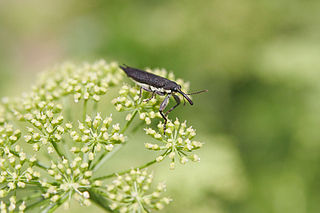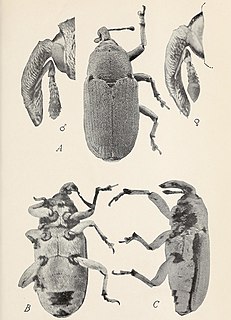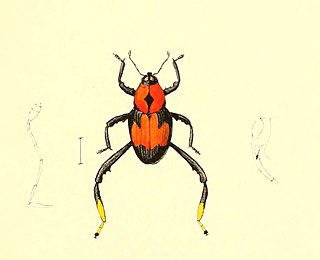
The Curculionidae are the family of the "true" weevils. They are one of the largest animal families, with 6,800 genera and 83,000 species described worldwide. They are the sister group to the family Brentidae.

Weevils are beetles belonging to the superfamily Curculionoidea, known for their elongated snouts. They are usually small, less than 6 mm in length, and herbivorous. Approximately 97,000 species of weevils are known. They belong to several families, with most of them in the family Curculionidae. Some other beetles, although not closely related, bear the name "weevil", such as the biscuit weevil, which belongs to the family Ptinidae.

Anthonomus is a genus of weevils. This genus includes major agricultural pests such as the boll weevil, strawberry blossom weevil, and pepper weevil, as well as promising biological pest control agents such as Anthonomus santacruzi.

Belidae is a family of weevils, called belids or primitive weevils because they have straight antennae, unlike the "true weevils" or Curculionidae which have geniculate (elbowed) antennae. They are sometimes known as "cycad weevils", but this properly refers to a few species from the genera Parallocorynus and Rhopalotria.

Otiorhynchus is a large genus of weevils in the family Curculionidae. Many species of the genus, particularly the black vine weevil and the strawberry root weevil, are important pests, both as larvae and as adults. Larvae feed on plant roots. Adults are flightless with fused elytra and feed at night on plant foliage. In many species of the genus at least some races are polyploid and parthenogenetic, while the rest of the races and species are diploid and bisexual. Otiorhynchus weevils, particularly O. scaber, have been a popular subject for studies of the evolution of parthenogenesis. The genus is native to the Palearctic region. However, sixteen species were inadvertently introduced to North America and have become widespread there.

Sitona is a large genus of weevils in the family Curculionidae native to the Nearctic and Palaearctic regions. Over 100 species have been described. Sitona is easily distinguished from related genera by flat, recumbent scales on the mandibles, by the absence of an oval scar on the mandibles, by short and broad rostrum with a deep, longitudinal, median groove, and by dense scales on the body.

The Entiminae are a large subfamily in the weevil family Curculionidae, containing most of the short-nosed weevils, including such genera as Entimus, Otiorhynchus, Phyllobius, Sitona, and Pachyrrhynchus. In comparison with their stunning diversity, only a few of these weevils are notorious pests of major economic importance. Entimines are commonly encountered in the field, including urban environments, and abundant in entomological collections.

Rhynchophorus, or common name palm weevil, is a genus of beetles in the weevil family, Curculionidae. Palm weevils are major pests of various trees in the family Arecaceae throughout the tropics including: coconut, Areca catechu, species of the genus Phoenix, and Metroxylon sagu.

Ceutorhynchini is a true weevil tribe in the subfamily Baridinae.

Trichobaris is a genus of flower weevils in the family Curculionidae. There are 8 to 13 species in genus Trichobaris.

Trichobaris mucorea, the tobacco stalk borer, is a species of flower weevil in the family Curculionidae. It is found in North America.
Aulobaris is a genus of flower weevils in the beetle family Curculionidae, with about eight described species.
Micralcinus is a genus of true weevils in the beetle family Curculionidae. There are about five described species in Micralcinus.

Pachytychius is a genus of true weevils in the beetle family Curculionidae. There are at least 110 described species in Pachytychius.

Heilipus is a genus of pine weevils in the beetle family Curculionidae. There are more than 280 described species in Heilipus.
Trichobaris compacta is a species of flower weevil in the beetle family Curculionidae. It is found in North America.

Listroderes is a genus of underwater weevils, subfamily Cyclominae, in the beetle family Curculionidae. There are more than 170 described species in Listroderes.
Hesperobaris is a genus of flower weevils in the beetle family Curculionidae, with currently one described species in North America.

Copturus is a genus of true weevils in the beetle family Curculionidae. There are more than 190 described species in Copturus.
Nealiolus curculionis is a species of parasitic wasp in the family Braconidae. It is a parasitoid of the sunflower stem weevil Cylindrocopturus adspersus, and a number of other species of stem-boring weevils.













